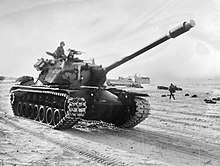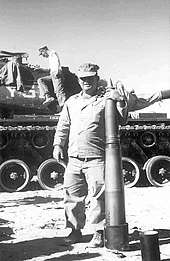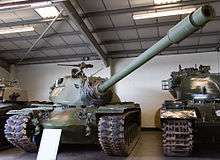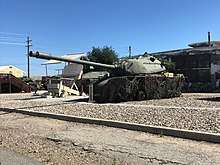M103 (heavy tank)
The M103 Heavy Tank (officially designated 120mm Gun Combat Tank M103, initially T43)[4] was a military vehicle that served in the United States Army and the United States Marine Corps during the Cold War. The last M103s were withdrawn from service in 1974. The M103 was the last heavy tank to be used by the US military as the concept of the main battle tank evolved, making heavy tanks obsolete.
| M103 heavy tank | |
|---|---|
 | |
| Type | Heavy tank[2] |
| Place of origin | United States |
| Service history | |
| In service | 1957–1974 |
| Production history | |
| Manufacturer | Chrysler |
| No. built | 300 |
| Variants | M103A1, M103A2 |
| Specifications | |
| Mass | 65 short tons (58 long tons; 59 t) |
| Length | 37 ft 2 in (11.33 m) |
| Width | 12 ft 2 in (3.71 m) |
| Height | 10 ft 6 in (3.20 m) |
| Crew | 5 (commander, gunner, driver, 2 loaders) |
| Armor | 127 mm (5 in) @ 60 degrees[3] 254 mm LoS (10 in) |
Main armament | 120 mm gun M58, 34 rounds |
Secondary armament | 2×.30-cal (7.62 mm) M1919A4E1 machine gun (co-axial) 1×.50-cal (12.7 mm) M2 AA machine gun |
| Engine | (M103A1) Continental AV1790 12-cylinder air-cooled gasoline 810 hp (604 kW) (M103A2) Continental AVDS-1790-2, V12, air-cooled, twin turbocharged diesel 750hp (560kW) |
| Power/weight | M103A2: 12.7 hp (9.5 kW) / tonne |
| Transmission | General Motors CD-850-4A or -4B, 2 ranges forward, 1 reverse |
| Suspension | torsion bar |
| Fuel capacity | 280 US gallons (710 liters) |
Operational range | M103: 80 mi (130 km) M103A2: 295 mi (480 km) |
| Maximum speed | M103: 21 mph (34 km/h) M103A2: 23 mph (37 km/h) |
Design and development
In December 1950 the Army made blueprints for a heavy tank reference design.[5] In January 1951 the Army awarded Chrysler a $99 million contract to produce the tank.[6] Chrysler tasked Robert T. Keller, the son of Chrysler Board Chairman K.T. Keller, with overseeing the design of the tank and construction of the Newark tank plant that would be used to produce it.[5]
The first T43 pilot model was completed in November 1951 at the newly built Chrysler tank plant in Newark, Delaware. Officials said the tank would "out-slug any land-fighting machine ever built."[7]
Like the contemporary British Conqueror tank, the M103 was designed to counter Soviet heavy tanks, such as the later IS-series tanks or the T-10 if conflict with the Soviets broke out. Its long-ranged 120 mm cannon was designed to hit enemy tanks at extreme distances.
In 1953–54 a series of 300 tanks, initially designated T43E1, were built at the Newark plant. Specifics about the tank, including production plans and specifications, were kept secret. Seeking to keep the tank out of public sight, Secretary of Defense Charles E. Wilson nixed an October 1953 exhibition for the American Ordnance Association at Aberdeen Proving Ground.[8] In May 1954 the tank was debuted publicly at a demonstration at the Newark tank plant.[9]
In 1953 the Pentagon began a reversal of the President Truman administration policy of a broad production base in favor of Wilson's "single, efficient producer" concept. In September Wilson chose General Motors over Chrysler to take over production of the M48 Patton. General Motors would become heir to any additional T43 orders after Chrysler tank production wrapped up in June 1954.[10]
Testing was unsatisfactory; the tanks failing to meet Continental Army Command's standards and the tanks were put into storage in August 1955. After 98 improvement modifications were approved, in April 1956 the tank was designated the M103 Heavy Tank.[11] Of the 300 T43E1s built, 80 went to the US Army (74 of which were rebuilt to M103 standard), and 220 were accepted by the US Marine Corps, to be used as infantry support, rebuilt to improved M103A1, then M103A2 standards.
A House Government Operations subcommittee report in July 1957 called for the heavy tank program to be audited. Investigators had been unable to determine the cost of the program, which was estimated in the hundreds of millions of dollars. The report said the Army had hastened production of the tank for war in Korea despite there being no need for it there. The tank was also unsuited to the rigors of the nuclear battlefield, the report said.[12]
Following contemporary American design philosophy, the M103 was built with a two-piece, cast elliptic armor scheme, similar to the M48's design. It featured seven road wheels per side, mounted with long-arm independent torsion bars. The 28-inch (71 cm) track was shoed in steel backed rubber chevron tracks, allowing for a ground pressure of 12.9 psi. The Continental AV-1790 engine was placed at the rear of the tank, and produced a maximum output of 810 horsepower (600 kW) and 1,600 pound force-feet (2,200 N⋅m) of torque, fed through a General Motors CD-850-4 two-speed transmission. This allowed the 60-ton heavy tank to achieve a maximum road speed of 34 kilometres per hour (21 mph) and a maximum climbing gradient of 60%.
Initial production versions suffered a host of drivetrain mechanical problems. The Continental powerpack, shared by the much lighter M48/M60 tanks, was insufficient to drive the much heavier M103. The resulting performance of the tank was dismal; being severely underpowered and very fuel intensive. This presented a host of logistical problems for the vehicle, most prominently the extremely limited range of just 80 miles (130 km). Though this was partially corrected with the introduction of the AV-1790-2 diesel unit, it would remain cumbersome and fuel-thirsty for the majority of its service life.
For ease of production, many of the large components of the tank were made from cast armor. This design scheme was also much more mass efficient than traditional rolled plate armor. Despite being better protected than the T29-series of prototypes which preceded it, the M103 was nearly 10 tons lighter, making it competitive with the Soviet T-10/IS-8 tank. The frontal hull glacis was a compound pike, welded at the center seam, with up to 10 inches thick armor at the front. The turret was a massive single-piece cast design, fitted with heavily sloped 10-inch (254 mm) rolled-homogenous armor.
The M103 was designed to mount the 120 mm M58 gun, fitted in the M89 turret mount. Using standard Armor-Piercing Ballistic Cap Tracer Rounds, it was capable of penetrating 221-millimetre (8.7 in) of 30-degree sloped rolled-homogenous armor at 1,000 yards and 196-millimetre (7.7 in) at 2,000 yards. It could also penetrate 124-millimetre (4.9 in) 60-degree sloped rolled-homogenous armor at 1,000 yards and 114-millimetre (4.5 in) at 2,000 yards. The commander could select from 34 rounds of either M358 Armor-Piercing Ballistic Cap Tracer Rounds or M469 HEAT shells, mounted at the rear of the turret and in the hull. With both loaders, the maximum firing rate of the gun was five rounds per minute, owing to the design of the two-piece ammunition. Using the electrohydraulic turret traverse, the gunner could turn the turret at 18 degrees per second, with 15 degrees of elevation and 8 degrees of gun depression.
The armor was made from welded rolled and cast homogeneous steel of varying thickness.

| Aspect | Thickness | Angle to vertical |
|---|---|---|
| Hull front, upper | 5 inches (127 mm) | 60 degrees |
| Hull front, lower | 4.5 inches (114 mm) | 50 degrees |
| Hull side, upper | equals 2 inches (51 mm) | 40 degrees |
| Hull side, lower | equals 1.75 inches (44 mm) | 30 degrees |
| Hull top | 1 inch (25 mm) | 90 degrees |
| Hull floor, front | 1.5 inches (38 mm) | 90 degrees |
| Hull floor, rear | 1.25 inches (32 mm) | 90 degrees |
| Turret mantlet | 10 to 4 inches (254 mm to 102 mm) | 0 to 45 degrees |
| Turret front | 5 inches (127 mm) | 50 degrees |
| Turret side | 5.38 to 2.78 inches (137 mm to 70 mm) | 20 to 40 degrees |
| Turret rear | 2 inches (51 mm) | 40 degrees |
| Turret top | 1.5 inches (38 mm) | 85 to 90 degrees |
Service

In Europe, the US Army fielded only one battalion of heavy tanks, from January 1958, originally assigned to the 899th Tank Battalion, later re-designated the 2d Battalion, 33d Armor.[4] The US Army heavy armor battalion, in contrast to other armor units, was organized into four tank companies, composed of six platoons each, of which each platoon contained three M103s, for a total of 18 tanks per company. Standard US Army armor battalions at the time had three companies per battalion, each with three five-tank platoons, with 17 tanks per company (two tanks were in headquarters platoon). The US Marine Corps assigned one M103 company to each of its three Marine tank battalions, including its Marine reserve units.[14] The M103 was never used in combat.
While the US Army deactivated its heavy armor units with the reception of the new M60 series main battle tanks in 1963, the remaining M103s stayed within the US Marine Corps inventory until they began receiving the M60 series main battle tank. With the disappearance of the heavy tank from US forces came the full acceptance of the main battle tank in 1960 for the US Army, and 1973 for the US Marine Corps.[15]
Ammunition

The ammunition fired by the M103's M58 cannon
- M358 APBC-T
- M356 HE-T
- M357 WP-T
- M359E2
- M469 HEAT-T
Variants

- T43 – Six pilot vehicles produced in 1951.[16]
- T43E1 – 300 built in 1953.
- T43E2 – Two vehicles produced from 1955–56. Turret basket and gunner moved to front of turret. New targeting system (T52 rangefinder, T33 computer, T44 gunners periscopic sight) and hydraulic turret traverse replaced with electric
- M103 – Produced in 1957. 74 converted into other models.
- M103A1 Produced in 1959. 219 converted or rebuilt. New sight (Stereoscopic T52) and M14 ballistic computer. Removed one coaxial machine gun. New turret electric amplidyne system traverse. Turret basket.
- M103A2 Produced 1964. 153 converted or rebuilt. New 750 hp (559 kW) diesel engine from the M60 tank, increasing the road range to 295 mi (480 km) and maximum speed to 23 mph (37 km/h). The M15 Stereoscopic Rangefinder is replaced to M24 Coincidence Rangefinder.
- Heavy Recovery Vehicle M51 Initially built 1954–1955 and modified 1956–58 to bring up to standard. Tank recovery version of the M103 heavy tank. 187 built by Chrysler.[17]
- Manned Evasive Target Tank M103A2s modified in 1977 for use as targets in training TOW missile crews (firing dummy warheads).[18]
Operators
- United States
- The U.S. Army operated 80 T43E1 tanks, 74 of them were later converted to the M103 standard.
- The U.S. Marines operated 220 T43E1 tanks, 219 of them which were later converted to the M103A1 then 154 were rebuilt to the M103A2 standard.
Surviving examples

There are several M103s in existence, including the late M103A2 version.
| Where | Model |
|---|---|
| Range 408A, Camp Pendleton, California | Blown out, former practice target, now a rattlesnake nest |
| U.S. Army Ordnance Center and Museum at the Aberdeen Proving Grounds | M103 |
| Radcliff, Kentucky | M103 |
| Shively, Kentucky | M103A2 |
| Rod Lowe Post #124 American Legion, Greensburg, Kentucky | M103A1 |
| Fort Lewis, Washington | M103A2 |
| Fort McClellan, Anniston, Alabama | M103A2 |
| 45th Infantry Museum, Oklahoma City, Oklahoma | M103A2 |
| Armed Forces Center, Syracuse, New York | M103A2 |
| Credit Island Park, Davenport, Iowa | M103 |
| Military Vehicle Technology Foundation in Portola Valley, California | M103A2 |
| 3d Cavalry Regiment Museum, Fort Hood, Texas | M103 |
| Marine Corps Mechanized Museum, Camp Pendleton, California | |
| Newman Park, Sweetwater, Texas | non-functioning |
| Pioneer Park, Nacogdoches, Texas | non-functioning |
| Euclid City Hall, E. 222nd Street. Euclid, Ohio | |
| Heritage Center of the Yuma Proving Ground, Yuma, Arizona | |
| Dugway Proving Ground, Utah | M103 hulk for testing |
| Former VFW in Anniston, Alabama | |
| The Tank Museum, Bovington, UK | M103A2, running condition |
| American Armor Foundation Tank Museum, Danville, Virginia | |
| United States Army TACOM Life Cycle Management Command, Warren, Michigan | |
| Camp Shelby, Mississippi | M103 |
| National Armor & Cavalry Museum, Fort Benning, Georgia | M103A1, M103A2, T43 & M51 |
| Range 68 MOUT site, Fort Bragg, North Carolina | non-functioning |
| US Marine Corps Reserve Center, Yakima, Washington. This command has been moved onto the Yakima Firing Center, and they took their display tanks with them. They are no longer publicly accessible. The M103 is at 46°40'59.99"N 120° 27'10.94"W | M103A2 |
| A second vehicle is on display behind the old Marine Reserve Center, Yakima WA, at the Calvary Cemetery, at 46°34'28.79"N 120°32'21.26"W | M103A2 |
| Institute of Military Technology, Titusville, Florida | M103A2 |
| Clay County Veterans Memorial in Lineville City Park, Lineville, Alabama | |
| Camp Roberts Historical Museum, Camp Roberts, California | non-functioning, rusted interior, missing track pieces and wheels on the exterior |
| Fort Huachuca, Arizona, at 31°37'27.94"N 110°19'45.42"W, 31°37'28.04"N 110°19'38.20"W, and 31°37'30.04"N 110°19'36.56"W. 1 other is unlocated. | 4 M103A2s |
References
- Hunnicutt (1984), p. 35.
- Hunnicutt (1984), p. 35.
- Hunnicutt, R.P. Firepower. Presidio. p. 114.
- Hunnicutt (1988), p. 134
- Palmer, C.B. (27 April 1951). "Fifty-Ton Monsters With a Mighty Punch". The New York Times. Retrieved 24 August 2018.
- Abel, Elie (19 January 1951). "Chrysler to Build a New Super-tank". The New York Times. Retrieved 25 August 2018.
- "Super-Tank--It Will 'Outslug Anything'-- Built 10 Months After Plant Was Started". The New York Times. 19 December 1951. Retrieved 24 August 2018.
- "New Tank Display Vetoed by Wilson". The New York Times. 4 October 1953. Retrieved 25 August 2018.
- Weart, William G. (14 May 1954). "Long-Secret Tank Tested In Public". The New York Times. Retrieved 25 August 2018.
- Abel, Elie (12 September 1953). "G. M. Is Heir to New Orders". The New York Times. Retrieved 25 August 2018.
- Hunnicutt (1984) p. 124.
- Trussell, C.P. (31 July 1957). "Tank Order Held a Costly Failure". The New York Times. Retrieved 25 August 2018.
- Hunnicutt, R.P. Firepower. Presidio. p. 205.
- Hunnicutt (1988), p. 140
- Hunnicutt (1984), p. 78.
- Hunnicutt (1984) p. 115.
- Hunnicutt (1984), pp. 161–162.
- Hunnicutt (1984), p. 160.
Bibliography
- Hunnicutt, R. P. Firepower: A History of the American Heavy Tank. 1988; Presidio Press. ISBN 0-89141-304-9.
- Hunnicutt, R. P. Patton: A History of the American Main Battle Tank. 1984; Presidio Press. ISBN 0-89141-230-1.
| Wikimedia Commons has media related to M103 Heavy tank. |